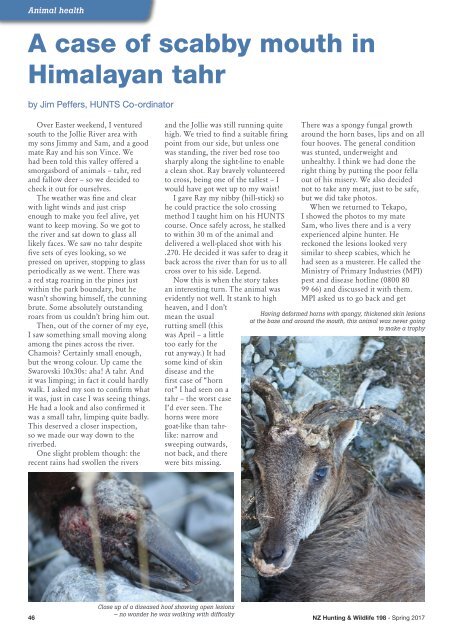NZDA H&W 198 WEB
You also want an ePaper? Increase the reach of your titles
YUMPU automatically turns print PDFs into web optimized ePapers that Google loves.
Animal health<br />
A case of scabby mouth in<br />
Himalayan tahr<br />
by Jim Peffers, HUNTS Co-ordinator<br />
Over Easter weekend, I ventured<br />
south to the Jollie River area with<br />
my sons Jimmy and Sam, and a good<br />
mate Ray and his son Vince. We<br />
had been told this valley offered a<br />
smorgasbord of animals – tahr, red<br />
and fallow deer – so we decided to<br />
check it out for ourselves.<br />
The weather was fine and clear<br />
with light winds and just crisp<br />
enough to make you feel alive, yet<br />
want to keep moving. So we got to<br />
the river and sat down to glass all<br />
likely faces. We saw no tahr despite<br />
five sets of eyes looking, so we<br />
pressed on upriver, stopping to glass<br />
periodically as we went. There was<br />
a red stag roaring in the pines just<br />
within the park boundary, but he<br />
wasn’t showing himself, the cunning<br />
brute. Some absolutely outstanding<br />
roars from us couldn’t bring him out.<br />
Then, out of the corner of my eye,<br />
I saw something small moving along<br />
among the pines across the river.<br />
Chamois? Certainly small enough,<br />
but the wrong colour. Up came the<br />
Swarovski 10x30s: aha! A tahr. And<br />
it was limping; in fact it could hardly<br />
walk. I asked my son to confirm what<br />
it was, just in case I was seeing things.<br />
He had a look and also confirmed it<br />
was a small tahr, limping quite badly.<br />
This deserved a closer inspection,<br />
so we made our way down to the<br />
riverbed.<br />
One slight problem though: the<br />
recent rains had swollen the rivers<br />
and the Jollie was still running quite<br />
high. We tried to find a suitable firing<br />
point from our side, but unless one<br />
was standing, the river bed rose too<br />
sharply along the sight-line to enable<br />
a clean shot. Ray bravely volunteered<br />
to cross, being one of the tallest – I<br />
would have got wet up to my waist!<br />
I gave Ray my nibby (hill-stick) so<br />
he could practice the solo crossing<br />
method I taught him on his HUNTS<br />
course. Once safely across, he stalked<br />
to within 30 m of the animal and<br />
delivered a well-placed shot with his<br />
.270. He decided it was safer to drag it<br />
back across the river than for us to all<br />
cross over to his side. Legend.<br />
Now this is when the story takes<br />
an interesting turn. The animal was<br />
evidently not well. It stank to high<br />
heaven, and I don’t<br />
mean the usual<br />
rutting smell (this<br />
was April – a little<br />
too early for the<br />
rut anyway.) It had<br />
some kind of skin<br />
disease and the<br />
first case of “horn<br />
rot” I had seen on a<br />
tahr – the worst case<br />
I’d ever seen. The<br />
horns were more<br />
goat-like than tahrlike:<br />
narrow and<br />
sweeping outwards,<br />
not back, and there<br />
were bits missing.<br />
There was a spongy fungal growth<br />
around the horn bases, lips and on all<br />
four hooves. The general condition<br />
was stunted, underweight and<br />
unhealthy. I think we had done the<br />
right thing by putting the poor fella<br />
out of his misery. We also decided<br />
not to take any meat, just to be safe,<br />
but we did take photos.<br />
When we returned to Tekapo,<br />
I showed the photos to my mate<br />
Sam, who lives there and is a very<br />
experienced alpine hunter. He<br />
reckoned the lesions looked very<br />
similar to sheep scabies, which he<br />
had seen as a musterer. He called the<br />
Ministry of Primary Industries (MPI)<br />
pest and disease hotline (0800 80<br />
99 66) and discussed it with them.<br />
MPI asked us to go back and get<br />
Having deformed horns with spongy, thickened skin lesions<br />
at the base and around the mouth, this animal was never going<br />
to make a trophy<br />
46<br />
Close up of a diseased hoof showing open lesions<br />
– no wonder he was walking with difficulty<br />
NZ Hunting & Wildlife <strong>198</strong> - Spring 2017


